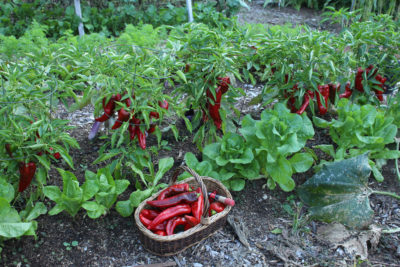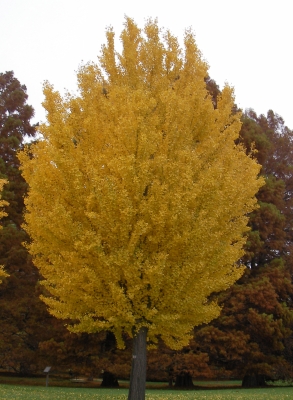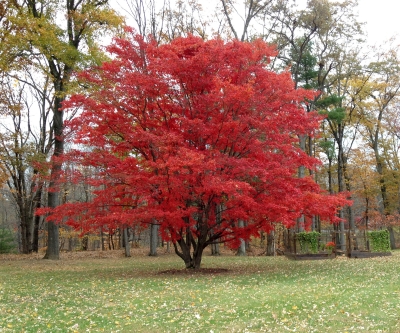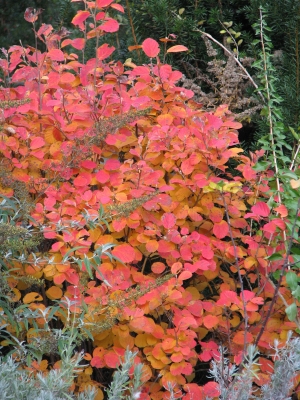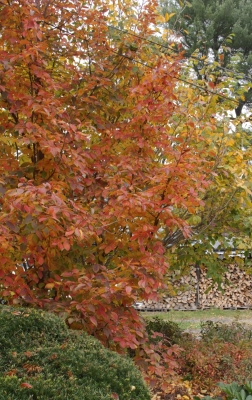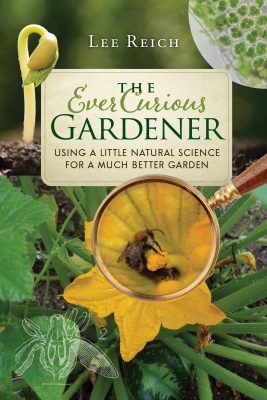Mo’ Plants
Cyclamen Addict
I’ll admit to being an addict. But my addiction — to propagating plants — is benign. It pains me to throw away an interesting seed or pruned-off stem; either can grow into a whole new plant, anything from a charming little flower to a towering tree.
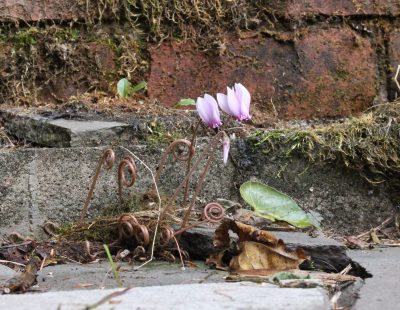
Hardy cyclamen self-sown seedling
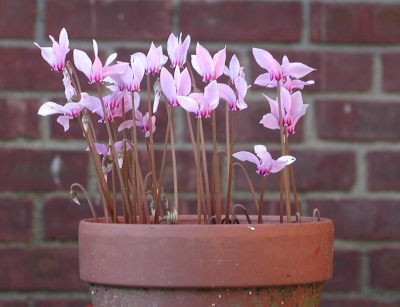
Hardy cyclamen in pot
Case in point are some cyclamen seeds I collected and sowed a couple of years ago. The mother plant is Cyclamen hederifolium, a species that differs from the large, potted cyclamens you now see offered in garden centers, hardware stores, even supermarkets. Cyclamen hederifolium is cold-hardy here, so comes back year after years planted outdoors in the ground, and it’s a dainty plant, with small flowers and commensurately small leaves. Otherwise it looks just about the same as the widely sold commercial species, the pink or white flowers hovering like butterflies on thin stalks above the whorls of variegated leaves.
Following those flowers are seed capsules, mostly hollow balls the size of small marbles each attached to the plant by a stem that is wound up like a spring. It was in the beginning of the growing season 2 years ago that I sowed the seeds in a seed tray filled with sterilized potting mix. (I don’t usually sterilize my potting mixes but I didn’t want weeds to interfere with the slow-germinating seeds.) Eventually the seeds sprouted and I kept them watered, as needed, for good, albeit slow, growth.
Hardy cyclamen’s flowers fade and leaves melt into the ground as plants ease into dormancy with the approach of winter. Not my seedlings, though. I learned, years ago, not to push them into dormancy; instead, keep them growing as long as they want to until they’re ready to start storing energy. Which I did, with plenty of light and, as before, water as needed.
This summer, the plants were still growing — and still small — and I noticed some swelling beneath each plant. 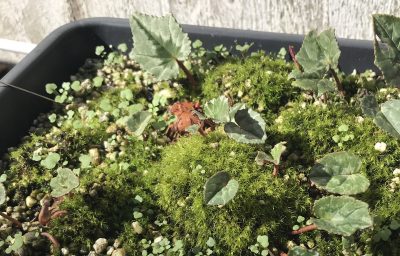 The youngsters finally were growing tubers, small bulb-like structures that will, in the future, store energy to carry the plants, dormant and leafless, through winter.
The youngsters finally were growing tubers, small bulb-like structures that will, in the future, store energy to carry the plants, dormant and leafless, through winter.
This time next year I expect my plants will be officially adult, with flowers as testimony to their maturity.
Little House Not on the Prairie
In her youth, my daughter periodically entered the world of Laura Ingalls Wilder, so the one acre, adjoining field we acquired became “the prairie.” Moving the playhouse I built out to the field would have completed the picture of “little house on the prairie.” The playhouse never got out there but the “prairie” — or “hayfield” — as I usually refer to it, has remained as such.
My affection for prairies came from my living 12 years in Wisconsin (and studying the rich soils — the richest in the world — underlying prairies). My daughter has long outgrown her prairie phase but I’m going to make my “prairie” more prairie-like. One plant for that purpose would be big bluestem (Andropogon gerardii), the star of the Big Four of grasses native to the tall grass prairies, the other three bering indiangrass (Sorghastrum nutans), switchgrass (Panicum virgatum), and little bluestem (Schizachyrium scoparium). Big bluestem is the tallest of the lot towering 6 to 10 feet high. It’s also good for hay and wildlife, and tolerates drought.
A few years ago I bought some big bluestem seeds and ended up with just a few plants. Those plants are now producing seed which — I can’t help myself — I’ve collected. 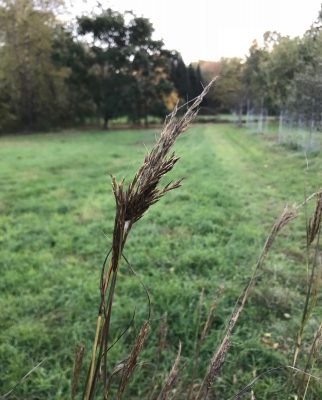 Not that some of the seeds wouldn’t self-sow near the mother plans, but seedlings that do sprout under natural conditions are subject to competition for light, nutrients, and water from other plants.
Not that some of the seeds wouldn’t self-sow near the mother plans, but seedlings that do sprout under natural conditions are subject to competition for light, nutrients, and water from other plants.
Like many fall-ripening seeds, big bluestem seeds won’t sprout as soon as they hit the ground; otherwise winter cold would do them in. So they need “stratification:” a false (or real) winter. For many seeds, cool, moist conditions, such as a few weeks residence in a mix of moist peat and perlite in a plastic bag in the refrigerator will do the trick. Big bluestem can also be coaxed out of its winter slumber with cool, dry conditions. Perhaps I’ll try both ways.
Bluestem Addiction
My present tallgrass prairie is only about 4 square feet, from two seedlings I originally planted plus their slow underground spread with rhizomes. Over time, with my additional plantings and help — a once a year, late winter mowing (taken care of under natural conditions with fire) — my prairie will swell.
A prairie takes time, as does, though less is needed, raising cyclamen to flower from seed. That time element itself brings with it certain satisfactions, both with the process and the result. That’s fortunate, since patience is an important element in successful propagation of plants.


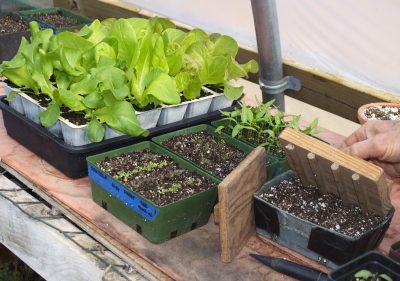 The endive seedlings will be ready to move out into the garden in 5 or 6 weeks. I’ve also sown more kale seeds to supplement the spring kale for harvest into and perhaps through (depending on the weather) winter.
The endive seedlings will be ready to move out into the garden in 5 or 6 weeks. I’ve also sown more kale seeds to supplement the spring kale for harvest into and perhaps through (depending on the weather) winter.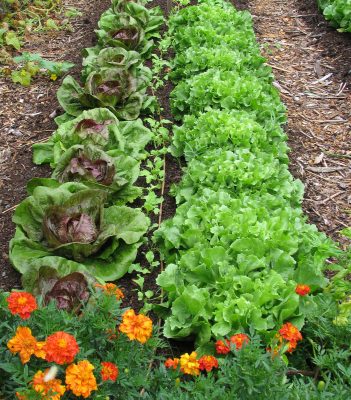
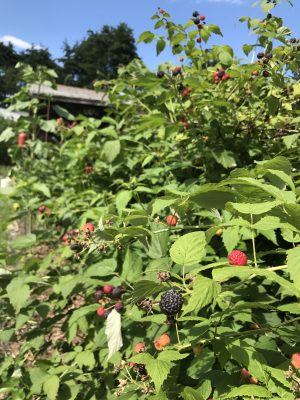
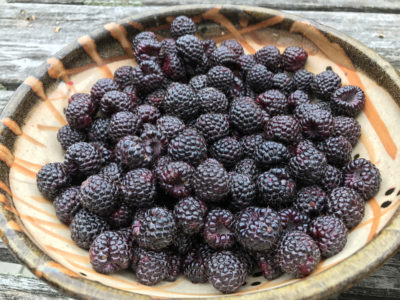
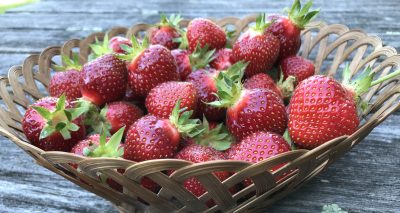
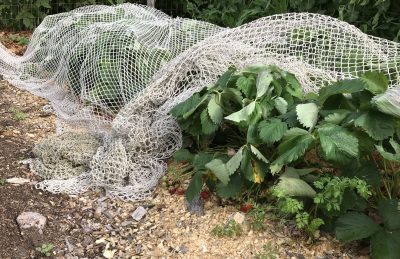 Once Earliglow stops bearing for the season, the bed will need renovation and, through the season, its runners pinched off weekly to keep each plant “spacey.”
Once Earliglow stops bearing for the season, the bed will need renovation and, through the season, its runners pinched off weekly to keep each plant “spacey.”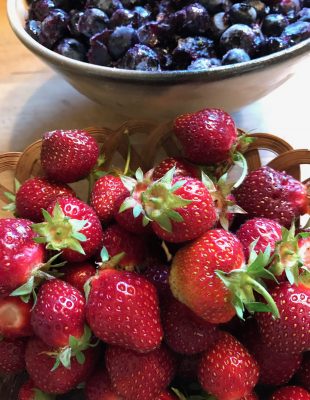
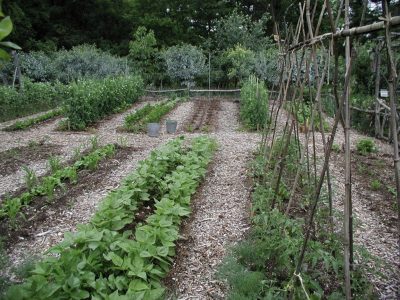
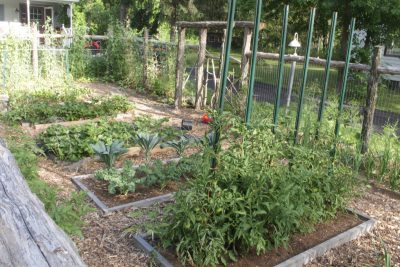
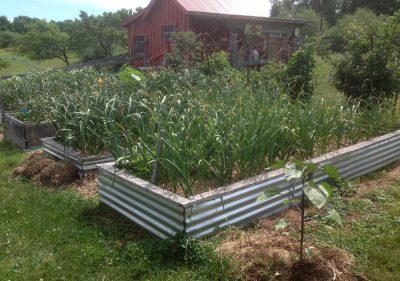 If the area is wet, though, taking soil from paths is going to lower them, making them that much wetter.
If the area is wet, though, taking soil from paths is going to lower them, making them that much wetter.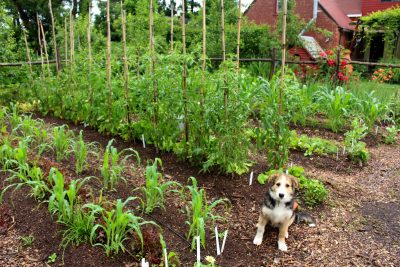 Paths get replenished with wood chips only if they start to get weedy or bare soil starts peeking through.
Paths get replenished with wood chips only if they start to get weedy or bare soil starts peeking through.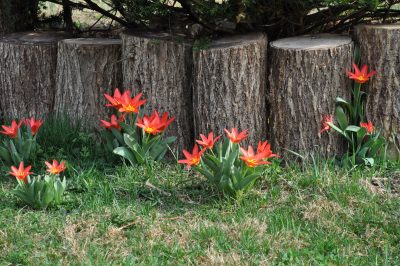 I’m banking, for instance, on the slightly warmer temperatures near the wall of my house to get my stewartia tree, which is borderline hardy here, through our winters. (It has.) And I expect spring to arrive early each year, with a colorful blaze of tulips, in the bed pressed up against the south side of my house. Proximity to paving also warms things up a bit.
I’m banking, for instance, on the slightly warmer temperatures near the wall of my house to get my stewartia tree, which is borderline hardy here, through our winters. (It has.) And I expect spring to arrive early each year, with a colorful blaze of tulips, in the bed pressed up against the south side of my house. Proximity to paving also warms things up a bit.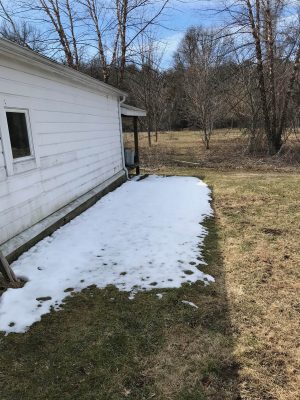 By planting the coveted blue poppy in a bed on the east side of my house, I hoped to give the plant the summer coolness that it demands. (That east bed was still too sultry; the plants collapsed, dead.)
By planting the coveted blue poppy in a bed on the east side of my house, I hoped to give the plant the summer coolness that it demands. (That east bed was still too sultry; the plants collapsed, dead.)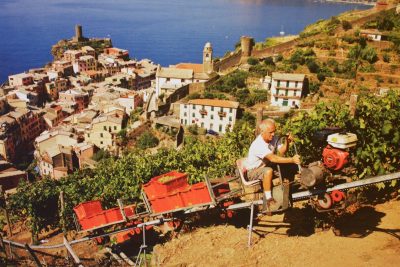
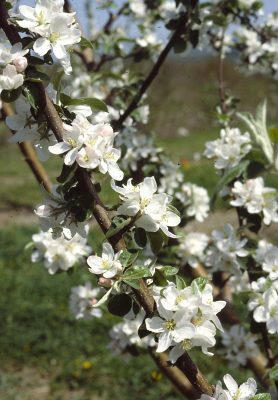 The cold air that settles here on clear spring nights increases the likelihood of late frosts and also causes moisture to condense on the plants, leaving them more susceptible to disease. Hence my envy for that sloping vineyard site.
The cold air that settles here on clear spring nights increases the likelihood of late frosts and also causes moisture to condense on the plants, leaving them more susceptible to disease. Hence my envy for that sloping vineyard site.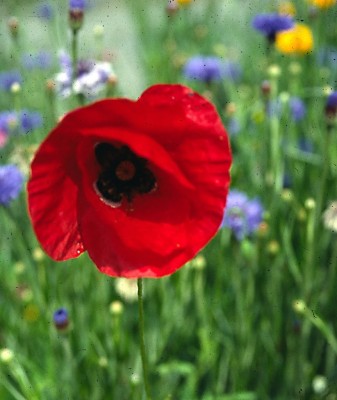
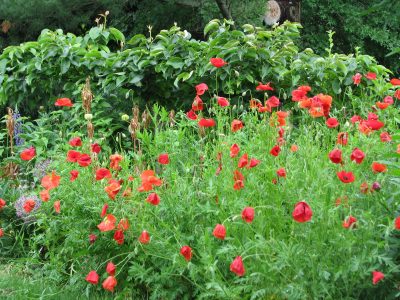
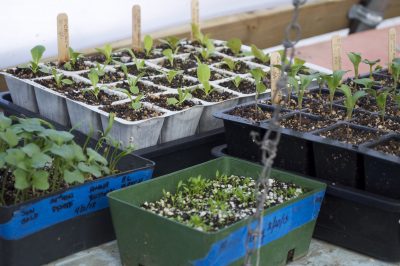 An exhaust fan keeps temperatures from getting too high, which, with lows in the 30s, would wreak havoc with plant growth, at the very least causing lettuce, mustard, and arugula to go to seed and lose quality too soon.
An exhaust fan keeps temperatures from getting too high, which, with lows in the 30s, would wreak havoc with plant growth, at the very least causing lettuce, mustard, and arugula to go to seed and lose quality too soon.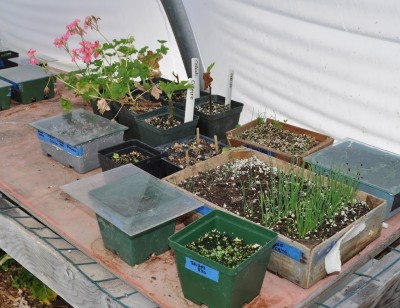
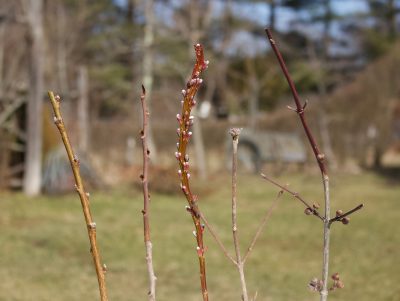
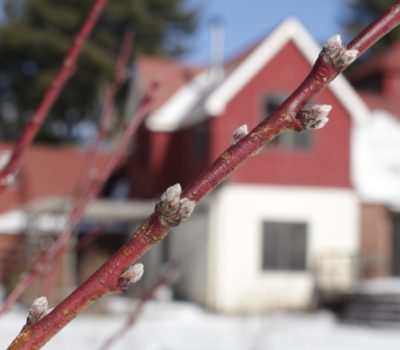
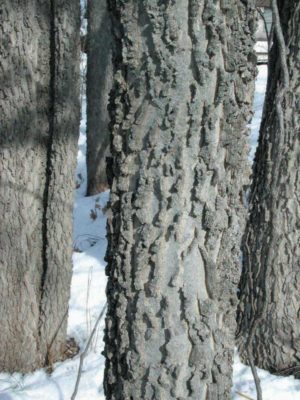
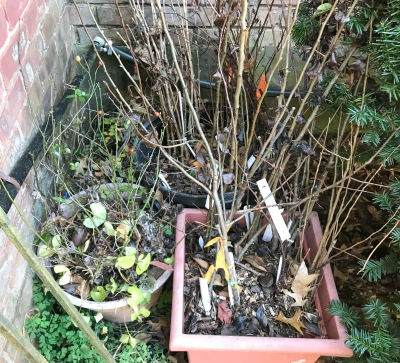 I’ve huddled all these pots together against the north wall of my house but soon have to mound leaves or wood chips up to their rims to provide further cold protection.
I’ve huddled all these pots together against the north wall of my house but soon have to mound leaves or wood chips up to their rims to provide further cold protection.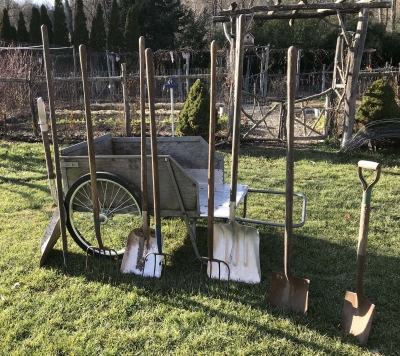 After the handles have been wiped down, 10 minutes later, they’ll be in good condition for at least another year.
After the handles have been wiped down, 10 minutes later, they’ll be in good condition for at least another year.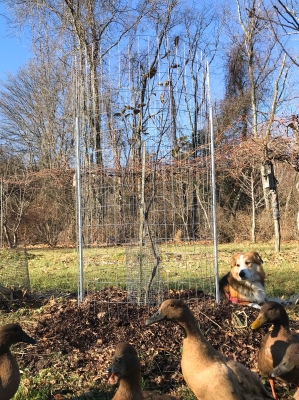 The pear trees, close to the house, don’t get bothered. The problem with such cages is that it’s a hassle to weed or prune within the cage — both very important for young trees. Two metal stakes, each a 5 feet length of EMT electrical conduit, woven into part of fencing on opposite sides allows me to slide the fence up and down to get inside a cage to work. These trees, which are replacing my very dwarf apple trees, are semi-dwarfs which can fend for themselves once they get above 5 feet. Then I’ll remove the cages.
The pear trees, close to the house, don’t get bothered. The problem with such cages is that it’s a hassle to weed or prune within the cage — both very important for young trees. Two metal stakes, each a 5 feet length of EMT electrical conduit, woven into part of fencing on opposite sides allows me to slide the fence up and down to get inside a cage to work. These trees, which are replacing my very dwarf apple trees, are semi-dwarfs which can fend for themselves once they get above 5 feet. Then I’ll remove the cages.